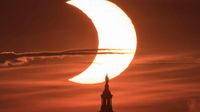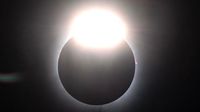Millions of Americans and people around the world are set to witness a captivating partial solar eclipse on March 29, 2025.
As this celestial event approaches, astronomy enthusiasts and casual observers alike are buzzing with excitement. The eclipse will commence around 6:30 a.m. to 7:00 a.m. ET, with varying viewing times depending on your location. Notably, while a recent total lunar eclipse was visible to many across the United States, this solar eclipse will be largely confined to the Northeast region.
NASA highlights, "In much of the Americas, including the Northeastern United States, the partial solar eclipse will already be in progress during sunrise." The event promises a visual spectacle, particularly for those located in cities like Boston, Massachusetts, Portland, Maine, and New York City, significantly enhancing the morning skies.
The eclipse will be observed notably in several global regions, including parts of Europe, Northern Asia, and even some areas of South America. However, the visibility will vary: New York City itself will see about 25% of the sun eclipsed.
For enthusiasts in the Northeast, the excitement builds not only from the eclipse itself but also from its unique visual effects. Residents in Maine—along with parts of Canada, New Brunswick, and Quebec—are poised to experience what astronomers are calling the “devil’s horns” effect, where two points of sunlight seem to protrude like horns during the early phases of the eclipse. This phenomenon occurs particularly during the eclipse's peak at sunrise, garnering nicknames like the “Cheshire cat smile” or “banana in the sky,” which describes the crescent shape that will emerge.
During a partial solar eclipse, the moon drifts between Earth and the sun, obscuring a portion of the sunlight—unlike a total solar eclipse where the sun is completely hidden. A partial eclipse allows observers to see a sliver of the sun, creating a breathtaking image in the sky. As noted by NASA: "When watching a partial solar eclipse directly with your eyes, you must look through safe solar viewing glasses ('eclipse glasses') or a safe handheld solar viewer at all times." Eye protection is critical, as viewing the eclipse without appropriate glasses can cause significant eye damage.
Many viewers may still have eclipse glasses from the spectacular total solar eclipse of 2024. For those in need of a new pair, the American Astronomical Society has provided a list of vetted suppliers where individuals can find safe solar filters and viewers. Richard Fienberg, an astronomer and senior advisor at the AAS, advises, “Don’t just randomly order them online. Check the AAS list.”
Beyond safety measures, viewers can also anticipate the picturesque “diamond ring effect,” a breathtaking moment during the eclipse where a sliver of light shines, resembling a sparkling diamond on a ring. This effect adds to the overall awe of watching the celestial display, much like peeking at the sun through a slightly obscured view when the moon is at its closest proximity.
The2ir expected intensity varies by location, with Portland, Maine experiencing about 64% obscuration while Halifax and St. John’s in Canada will see 83% and Nuuk in Greenland a striking 87%. Reykjavik, Iceland is also well-positioned for viewing, expecting around 68% obscuration.
The Royal Observatory Greenwich will provide a live broadcast of the event for those who may not have the opportunity to witness the eclipse in person. This can be accessed on their YouTube channel starting at 6 a.m., ensuring that everyone can partake in the experience.
As the day approaches, NASA encourages sky gazers to respect and protect their eyes while witnessing the event. Eclipses like these conjure enthusiasm for astronomy, moments that spark curiosity and love for the cosmos.
In a world that rapidly shifts focus from nature to technology, events like the solar eclipse serve as powerful reminders of our connections to celestial phenomena. Observing the beauty of these events can inspire us to look up and appreciate the wonders that exist beyond our atmosphere.
The anticipation for March 29, 2025, continues to swell as people prepare their viewing glasses, set their alarms, and plan gatherings to enjoy this remarkable astronomical experience together. Don’t miss out on this unique moment—it will certainly be a day to remember!



